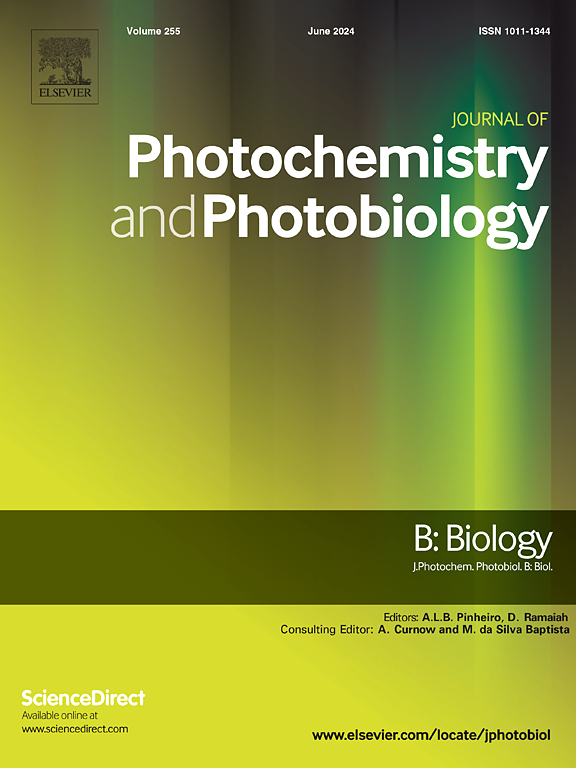Polyphenol production and gene expression in sage shoot cultures exposed to light-emitting diodes
IF 3.9
2区 生物学
Q2 BIOCHEMISTRY & MOLECULAR BIOLOGY
Journal of photochemistry and photobiology. B, Biology
Pub Date : 2025-01-23
DOI:10.1016/j.jphotobiol.2025.113106
引用次数: 0
Abstract
Sages and their beneficial secondary metabolites have been used in conventional and traditional medicine in many countries, and are extensively studied for their health effects. However, to achieve high production levels, it is crucial to optimize the cultivation conditions. The aim of our study was to determine the optimal light-emitting diode (LED) treatment strategy for promoting plant growth and polyphenol biosynthesis in S. atropatana and S. bulleyana in vitro cultures. Shoots of both species were grown under red, blue, mixed (70 % red and 30 % blue), or white (control) light. The lighting conditions affected not only culture growth and proliferation potential, but also the accumulation of polyphenols and the expression of the genes involved in their biosynthesis (PAL, TAT, RAS). The highest proliferation rates (6.21 for S. atropatana and 4.26 for S. bulleyana) were achieved under white LEDs. In contrast, the highest biomass production was observed under white and mixed red/blue light (both species), although a similar effect was revealed for the blue light treatment for S. bulleyana. The dominant polyphenol in both species was rosmarinic acid: its level was highest in S. atropatana shoots exposed to red light (20.86 mg/g dry weight, DW) and S. bulleyana under white light (19.72 mg/g DW). The effects of the light treatments on gene expression varied between plant species and the analyzed gene; for example, mixed light stimulated RAS expression in S. bulleyana shoots and inhibited it in S. atropatana shoots. Principal component analysis found that gene expression did not always translate directly into rosmarinic acid production. In summary, our findings indicate that optimized lighting conditions have a significant effect on the production of polyphenolic compounds in sage shoot cultures. However, further research is needed to find the relationship between light treatment and plant biosynthetic pathway.
暴露于发光二极管的鼠尾草芽培养中多酚的产生和基因表达。
在许多国家,鼠尾草及其有益的次生代谢物已被用于常规和传统医学,并被广泛研究其对健康的影响。然而,要达到高产量水平,优化栽培条件至关重要。本研究的目的是确定最佳的发光二极管(LED)处理策略,以促进S. atropatana和S. bulleyana离体培养植株生长和多酚生物合成。两种植物的芽分别生长在红色、蓝色、混合(70%红色和30%蓝色)或白色(对照)光下。光照条件不仅影响培养物的生长和增殖潜力,还影响多酚积累及其生物合成相关基因(PAL、TAT、RAS)的表达。在白光led下,S. atropatana的增殖率为6.21,S. bulleyana的增殖率为4.26。相比之下,白光和红蓝混合光处理(两种)下的生物量产量最高,尽管蓝光处理对S. bulleyana也有类似的效果。两种植物的优势多酚均为迷迭香酸,其含量在红光下最高(20.86 mg/g干重,DW),白光下最高(19.72 mg/g DW)。光照处理对基因表达的影响因植物种类和所分析基因而异;例如,混合光刺激了S. bulleyana枝条中RAS的表达,抑制了S. atropatana枝条中RAS的表达。主成分分析发现,基因表达并不总是直接转化为迷迭香酸的产生。综上所述,我们的研究结果表明,优化的光照条件对鼠尾草芽培养中多酚类化合物的产生有显著影响。然而,光处理与植物生物合成途径之间的关系还有待进一步研究。
本文章由计算机程序翻译,如有差异,请以英文原文为准。
求助全文
约1分钟内获得全文
求助全文
来源期刊
CiteScore
12.10
自引率
1.90%
发文量
161
审稿时长
37 days
期刊介绍:
The Journal of Photochemistry and Photobiology B: Biology provides a forum for the publication of papers relating to the various aspects of photobiology, as well as a means for communication in this multidisciplinary field.
The scope includes:
- Bioluminescence
- Chronobiology
- DNA repair
- Environmental photobiology
- Nanotechnology in photobiology
- Photocarcinogenesis
- Photochemistry of biomolecules
- Photodynamic therapy
- Photomedicine
- Photomorphogenesis
- Photomovement
- Photoreception
- Photosensitization
- Photosynthesis
- Phototechnology
- Spectroscopy of biological systems
- UV and visible radiation effects and vision.

 求助内容:
求助内容: 应助结果提醒方式:
应助结果提醒方式:


